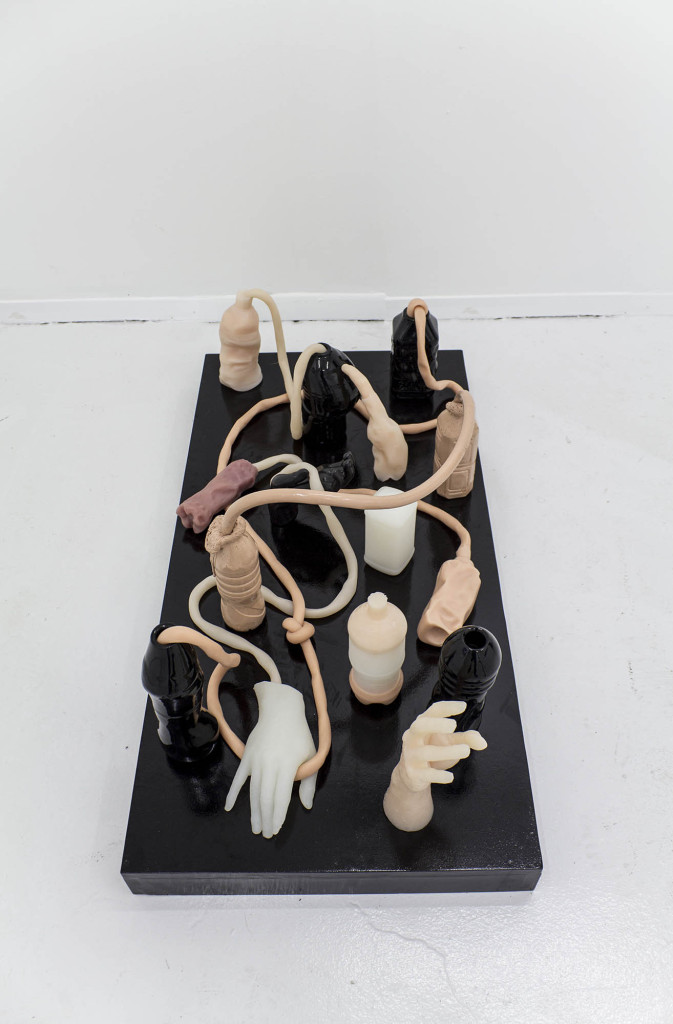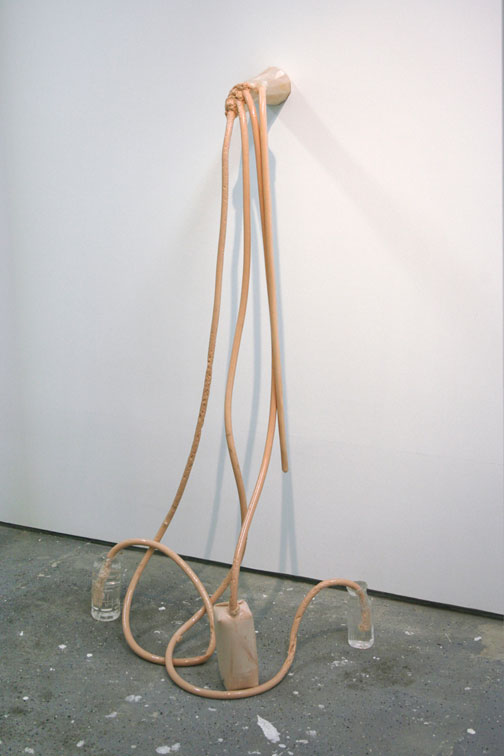ETTD Contributor Kari Adelaide recently interviewed artist Phillip Birch who performed as part of the closing to Nolan Simon’s exhibition at 47 Canal which was on view from January 8th through February 15th, 2015.
KARI ADELAIDE: Your sculptures appear like laboratory objects; there’s an instrumental control and unsettling sterility that seems to lead up to something unknown. Along with everyday forms like water bottles, you often include tubes that recall the organic, such as umbilical cords, or synthetic, like breathing and feeding tubes. They ambiguously evoke anxiety. You often incorporate a disembodied hand or a single glove, as a suggestion or trace more than anything. Can you tell us about these material choices and tendencies?
PHILLIP BIRCH: David Cronenberg has been a huge influence on my practice. His films have that sort of bodily fluid visceral quality that repulses viewers in a way that also brings them in closer, almost like strangling them. That’s the effect I want my sculptures to have; flesh-colored umbilical cords attach themselves to hands that attach themselves to vessels like a deformed milk jug. The deformed milk jug mimics some generic organ, possibly riddled with cancer which is connected by an umbilical cord to a hand reaching up. The whole thing is composed of a material that looks and feels like flesh. I want the viewer to touch these objects. There’s a circuit that’s not completed until the viewer actually feels the fleshy skin of the sculpture. There’s a gross tactility to the objects that is really important to the meaning of the work.
The hand (both the literal hand and its avatar) has superseded the eye in our mediation of technology and the world. The hand has become simulacra for the body, our digital avatar, a stand in for ourselves. With video games and touch screen devices the hand has replaced the eyes as the window of the soul. Maybe the hand as generic body part now represents the homogeneous nature of our representations. Of course the eye is still just as much part of the process as before, but the sense of how we are represented in this process is fundamentally different from holding a paint brush or pressing a key. It’s as if our internal world or eye is the screen and the process of interacting with the digital world is akin to touching or pressing our own eye. This somewhat gross analogy makes me think about the Body Without Organs and the undifferentiated, un-hierarchical realm that lies deeper than the world of appearances.

Phillip Birch, Detail, Tumorigenesis (Stage 1- Dyspeptic Desire Machines)
Ceramic, silicone, urethane foam, MDF, 2014, Image courtesy of the artist
KA: During a recent conversation when we chatted about your work in A Show Of Hands at 247365, you mentioned wanting your sculptures to seem like a prop in a sci-fi movie that might appear on the periphery, hardly noticed during a film scene. Can you tell us more about this film prop inspiration, and how have films and literary science fiction works influenced your practice?
PB: Though the works of Eva Hess, Lee Bontecou and Paul Thek have definitely informed and influenced my practice, films and science fiction in general have had more of an impact than any artwork. I feel an allegiance in particular to the spiritual component of Thek’s practice. I was raised Catholic and the residue of that mysticism continues to reverberate through my artwork. The eucharist is a concept I continue to play with and animate. In a way it’s connected to the body modification motif that plays out in Cronenberg’s films. Instead of a transcendent transformation of the spirit and body it is the further perversion of the body. I think Body Horror is more than just a genre, it’s more than just pathological, it’s an ideology, a way of being.
As far as the objects and their relationship to props, I think that’s part of how I come to terms with the act of object creation. For a long time I shied away from creating physical objects because of my fear of putting more things into an already over saturated world. Over 60 million plastic water bottles are consumed every day – that’s 22 billion a year. Thinking of my work as props or as conceptual stand-ins is a mental game more than anything and relates to my own interest in object-oriented ontologies. I like to think about what future archeologists (alien cultures) will think of these bizarre artifacts that we’ve left by the heap-load.

Phillip Birch, Tumorigenesis (Stage 1- Dyspeptic Desire Machines)
Ceramic, silicone, urethane foam, MDF, 2014, Image courtesy of the artist
KA: Your sculptures seem bodily yet beyond terrestrial. They harbor tension as uncanny arrangements of the pseudo-organic, speculative and artificial. How are you dealing with the dystopian technological imagination as it relates to the biological?
PB: A lot of this resides in my above statements about the eucharist and the act of transformation we are undergoing. I think about things like the supposed forthcoming Technological Singularity and how we are supposedly moving away from our own bodies into cyberspace or some sort of technological ether. But, I still feel pretty grounded in the gross disturbances of my body. We are ostensibly becoming ‘more human than human’ but I think that it is more of a perfection of our own bodies than a removal from them. We are inundated with a vast array of substances that claim to perfect our body or help transform ourselves into the perfect specimen. From bovine growth hormone to Muscle Milk to Gatorade. It is our connection to these things that my sculptures are often representing. I think about the dystopian in relation to the water bottles or Muscle Milk sculptures I make. They are about becoming more than human, but also about being these bizarre cultural relics left behind. I imagine all of this non-decomposing plastic residing next to the Statue of LIberty that Charlton Heston discovers at the end of Planet of the Apes.
KA: You’re also a writer and performer. How do your writings and performances relate to your recent sculptures? In your text, The Spectre As It Resolves Its Own Gravity, previously performed at 47 Canal, one senses a deeply involved universe; however, the specifics of this realm are never made clear. Speculation creeps in and lingers on an unresolved basis. It seems like you’re touching upon gestational narrative techniques, focusing on the genesis of a predicament. What does it mean to be raising questions in this way as opposed to traversing the full circle of a fantasy or science fiction narrative?
PB: I’ve always had a fascination with hermetic universes and the act of myth creation. This is where the best science fiction really succeeds. I want my practice to become its own cosmos or universe onto itself. The text for The Spectre As It Resolves Its Own Gravity is about coming to terms with my own political engagements. Primarily my involvement with Occupy Wall Street and how in retrospect I sometimes feel that political movements such as this only serve to reinforce hegemonic structures by creating the aura or myth of political agency. Now I’m not saying this is what I really believe, but it’s the recurrent fear that plays itself in my head. I liken it to the impotence of the film Brazil, where in the end all of the struggles against the Powers That Be are made futile. The shadow that I am interacting with in the play is that part of my consciousness that shuts down actions and works to nullify a sense of mattering in the universe. The dialogue draws comparisons between my own engagements and draws a historical corollary to the French Revolution and discusses agents involved with that political movement. The play/performance is supposed to take place in the moment between thought and action or as is more often the case between thought and inaction. This is partly why the text can be so obtuse and difficult to unpack. The play is meant to convey that moment of decision and not necessarily be an easily digested narrative. I liken the whole endeavor to a not nearly as well written Finnegan’s Wake, which takes place in the moments between being asleep and being fully awake.

Phillip Birch, Bio-digital Jazz, Man
PLA, urethane foam and silicone, 2013, Image courtesy of the artist
KA: Can you tell us about your upcoming show this spring, at Essex Flowers?
PB: In May I’ll be having a two person exhibition at Essex Flowers. For now I am keeping that other person under wraps but the show itself will be titled The Hand of God and will draw together my interest in science fiction and technology and history. It will also deal with time-travel and the ability to have a dialogue with someone in the past. I had performance at 47 Canal on February 15th that played with many similar concepts. It was titled The Crown of Modernity: An Intervention in the Napoleonic Age and featured a painting made specifically for the performance by Nolan Simon.
More soon!
xo

